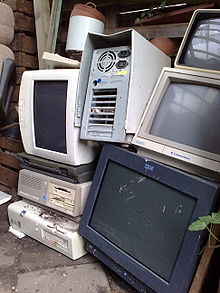
| Part of a series on |
| Pollution |
|---|
 |
Electronic waste (or e-waste) describes discarded electrical or electronic devices. It is also commonly known as waste electrical and electronic equipment (WEEE) or end-of-life (EOL) electronics.[1] Used electronics which are destined for refurbishment, reuse, resale, salvage recycling through material recovery, or disposal are also considered e-waste. Informal processing of e-waste in developing countries can lead to adverse human health effects and environmental pollution.[2] The growing consumption of electronic goods due to the Digital Revolution and innovations in science and technology, such as bitcoin, has led to a global e-waste problem and hazard. The rapid exponential increase of e-waste is due to frequent new model releases and unnecessary purchases of electrical and electronic equipment (EEE), short innovation cycles and low recycling rates, and a drop in the average life span of computers.[3]
Electronic scrap components, such as CPUs, contain potentially harmful materials such as lead, cadmium, beryllium, or brominated flame retardants. Recycling and disposal of e-waste may involve significant risk to the health of workers and their communities.[4]
- ^ Kahhat, Ramzy; Kim, Junbeum; Xu, Ming; Allenby, Braden; Williams, Eric; Zhang, Peng (May 2008). "Exploring e-waste management systems in the United States". Resources, Conservation and Recycling. 52 (7): 956. doi:10.1016/j.resconrec.2008.03.002.
- ^ "Electronic waste (e-waste)". www.who.int. Retrieved 7 April 2024.
- ^ Perkins, Devin N.; Drisse, Marie-Noel Brune; Nxele, Tapiwa; Sly, Peter D. (25 November 2014). "E-Waste: A Global Hazard". Annals of Global Health. 80 (4): 286–295. doi:10.1016/j.aogh.2014.10.001. PMID 25459330. S2CID 43167397.
- ^ Sakar, Anne (12 February 2016). "Dad brought home lead, kids got sick". The Cincinnati Enquirer. Archived from the original on 29 March 2022. Retrieved 8 November 2019.